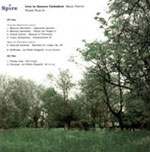

Various Artists
Spire: Live In Geneva Cathedral Saint Pierre
(Touch)
It is true that I was a bit rough on Spire: Organ Works Past Present & Future. It was one of those releases that struck me in a big way as style over substance and despite the pretty packaging and big names involved with the project, I felt that it was ultimately rather a letdown. Spire: Live In Geneva Cathedral Saint Pierre is the sequel to that release, and in a move that is ultimately very pleasing to me, it goes largely in a different direction than the first compilation in the series.
For starters, a good portion of the work on this release is actual, straightforward organ music by composers such as Marcus Davidson and Henryk Gorecki. In one of the great strokes of musical luck in my life, I managed to get to hear an organ concert that was given in Köln's Dom Kirche while there several years ago. It was easily one of the most moving musical performances that I've ever heard, and it gave me a much greater idea of the power of the instrument when played in such a massive structure. I think many people don't realize the expressive power of a massive pipe organ, but it's easy to become a believer after hearing one in such a setting. Along these same lines, all of the recordings on this newest Spire compilation (both straightforward organ pieces and electronicly-enhanced ones) were recorded live in the Geneva Cathedral and although it's certainly no substitue for being there in person, the recordings breath with a life that only enhances their quality.
Once again, the release is spread out over the course of two discs (containing almost two and a half hours worth of music), but as mentioned above, this time the setup is different. The first forty minutes of the first disc is taken up with five different pieces for organ, and the variety of them gives one a good idea of the range of expression the instrument truly has. The opening "Opposites Attract" by Marcus Davidson moves as the title somewhat suggests, playing back and forth between loud, majestic moments and quieter, more playful ones (as if the two sides of the piece are courting one another). "Hymne à l'Universe" by André Jolivet also starts out with lower rumblings, but morphs into something more lyrical while Henryk Gorécki's "Kantana For Organ Op. 26" works in almost an opposite direction, opening with waves of fury before settling into a minimal, dark middle section and finally attacking with the same ferocity at the end.
After the first five tracks, the compilation completely changes gears, moving into the electronic reworkings of organ pieces, and it's BJ Nilsen that fills up the rest of the first disc with a piece performed in the smaller chapel. At the start of the piece, one can hear the milling about of the audience, even a person coughing, and it actually lends itself to the development of the track as soon it moves into deep, dark registers and swallows up every outside sound source with it's reverberated rumblings. Nilsen plays both electronics (mainly one-note samples organ sounds) and actual organ on the piece, and it works quite well. About one-third of the way through the track, the whole things sounds like it's swallowing itself as a sharp-edge sears through the soft undulating folds of sound before again receding. The latter half of the track again calms and one can hear the stirring of audience members again while Nilsen plays droning notes on an organ and single cracks of noise break through the drone and reverberate into the distance. As a whole, it's a smidge overlong, but it's a great study in dynamics and one of the better pieces I've ever heard from Nilsen.
For longtime fans of the Touch label, it's the second disc that will get them most excited, and it's because there are epic new tracks from both Philip Jeck and Christian Fennesz. Jeck turns in a nearly forty-five minute piece recorded in an archeological site below the cathedral, and it's as dark as one might suspect, swimming along through dark undercurrents of warbling loops as lonely shapes burst through and the whole thing progresses towards some dark conclusion. Before dissolving into a finale of rather gorgeous shimmering, the track even lets a few riffs of what sounds to be death metal creep through. Not to be outdone, Fennesz offers up the nearly twenty-five minute piece (also recorded in the small chapel) that drifts with a warm Eno-esque haze of micro-sounds that is only once punctured with the sharp edge of glitched-out noise. The closing 10 minutes of the piece are among some of the more beautiful work that I've heard him create.
All in all, Spire: Live In Geneva Cathedral Saint Pierre is many steps beyond the first compilation in the series both in thought and actual output. The instrument itself is given a chance to shine on the opening tracks of the first disc, and while none of the pieces are among my favorites in terms of organ music, they set the groundwork well for the electronic pieces that follow, all of which seem to have more reverence towards the actual instrument than anything on the first compilation. Perhaps at least some of the power of the pieces can be attributed to the warm, soft reverb of the cathedral in which they were performed as well. Downright magical in places, this is one you'll want.
Rating: 8